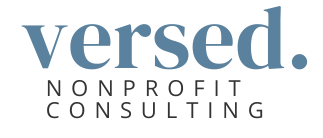How to Build Donor Trust Without Posting on Social Media Every Day
If you’ve ever stared at your nonprofit’s Instagram account and thought, “I have nothing to say today,” you’re not alone.
For small teams, keeping up with the content machine can feel like a full-time job in itself. There’s pressure to be everywhere — Instagram, LinkedIn, Facebook, maybe even TikTok — all while trying to write grants, manage programs, and actually do the work your mission exists to serve.
But here’s the truth: donor trust doesn’t come from frequency. It comes from clarity, consistency, and connection. And the good news is, you don’t need to post every day to earn it.
Let’s talk about what actually builds donor trust and where to focus your time when the social media hamster wheel just isn’t cutting it anymore.
Why Donor Trust Matters More Than Visibility Alone
It’s tempting to think that more visibility = more donations. But visibility without strategy can lead to burnout, inconsistency, and — ironically — less trust from your audience.
Donor trust is what drives giving. According to a Neon One donor trust report, 62% of donors say trustworthiness is the #1 reason they choose to give to a nonprofit, even more than how well-known the organization is.
That trust is built when your messaging feels clear, aligned, and consistent across platforms, not when you chase trends or rush to post to stay visible.
The Limits of Social Media for Small Nonprofits
Let’s be honest: social media can be powerful, but it’s not always the best return on investment, especially for lean teams.
Organic reach is declining on most social media platforms.
It’s hard to build meaningful relationships in 15-second Reels.
And worst of all? It creates a cycle of “we need to post just to keep up,” rather than “we’re communicating intentionally.”
If your current nonprofit marketing strategy relies solely on social media, it may be time to explore some high-trust alternatives that support digital donor engagement in a more sustainable way.
3 High-Trust Communication Channels That Work Better
If you’re ready to step off the content treadmill and build real connections, here are three channels that can deepen donor trust — no daily posting required.
1. Email Marketing (Especially a Welcome Series)
Email is one of the most underutilized trust-building tools in a nonprofit’s toolkit.
It’s direct. It’s personal. And when done well, it creates a consistent space for your supporters to hear from you, not just your logo.
A well-crafted donor welcome email series sets expectations, shares impact, and helps new subscribers feel seen. Even one thoughtful automated email can outperform a week’s worth of Instagram posts.
🔹 Pro Tip: Use your welcome series to introduce your Executive Director, share a donor story, and invite the reader to take a simple next step — like replying with why they care about your cause. Not sure where to start? Get my free welcome series course - a 5-day email series!
2. A Clear, Donor-Centered Donation Page
Want to build trust fast? Start with your donation page.
Many nonprofits still rely on templated forms or generic giving copy that feels more like a transaction than a relationship. But donors are people, not payment processors.
Your donation page is often the last thing a donor sees before deciding to give. Make it count.
Use plain, specific language that connects gifts to impact
Remove unnecessary distractions or extra steps
Include brief trust signals (like testimonials, program stats, or a short founder note)
🔹 Want help with this? My Donation Page Bootcamp is designed to overhaul your giving page in 10 days — with strategy-backed copy, layout support, and modern tools. Join the waitlist here!
3. Thought Leadership from the Executive Director
Donors give to people, not just causes.
When a nonprofit leader shares their voice on LinkedIn, in an email, or even in a short founder story on the website, it builds trust. It helps donors feel like they know who they’re giving to.
You don’t have to publish every week. Even one post per month that shares your perspective, your mission, or something behind the scenes helps humanize your brand and build confidence.
🔹 Looking for guidance on how to get started with thought leadership? My Thought Leadership Content Calendar is ideal for nonprofit leaders who want to establish a consistent online presence without burning out. Grab it here!
Choose the Strategy That Fits Your Reality
Here’s what I want you to take away: you don’t need to be everywhere to build trust.
Start with one or two strategies that feel sustainable. Prioritize depth over reach. Focus on showing up in a way that feels aligned, clear, and human.
When your communication supports your values — not just the algorithm — that’s when trust grows.
3 Ways to Build Donor Trust This Week
Send one donor a thank-you note that feels personal and heartfelt. No template needed.
Review your donation page and ask: Would I feel confident giving here?
Write a short reflection (on LinkedIn or in your newsletter) about a recent win, challenge, or moment that reminded you why your work matters.
